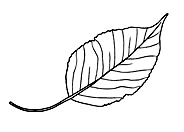Bradford pear
Poirier 'Bradford'
Pyrus calleryana 'Bradford'Rosaceae (rose family)Origin: China (cultivated variety)

Origin: China (cultivated variety)

Bradford pear is a small to medium tree, with a dense, oval crown.
Read more about Tree, Bark, TwigsLeaves are glossy, widest below the middle with round-toothed edges and pointed tips
Read more about LeavesFlowers, borne in clusters, are small with 5 white petals and dark purple anthers.
Read more about FlowersFruits are small and round (not the classical "pear" shape) and are often borne in dense clusters.
Read more about FruitLeaves are glossy, 4 - 7.5 cm (1 1/2" - 3") long, widest below the middle and tapering to a pointed tip.
Leaves on new long shoots are arranged alternately on the branch, as are short shoots that bear clusters of leaves early in the season. .
Distribution
Bradford pear is one of the many cultivated varietes of Callery pear (Pyrus calleryana), which is native to Korea and China.Callery pear, named after Joseph Callery, a French priest who collected the species in China in 1858, was brought to the United States in the 20th century as part of an effort to develop a cultivated variety of pear that was resistant to fireblight, a destructive pest that attacks pear trees. The project was unsuccessful but, in the process, United States Department of Agriculture plant scientists created the Bradford pear, which has been widely planted in cities since 1963.
Bradford pear is named for Frederick Charles Bradford, the director of the USDA Plant Introduction Station in Glenn Dale, Maryland, where the Bradford pear was developed.
Bradford pear's place in Toronto's urban forest
Since its creation, Bradford pear has proven to be a popular urban tree and has been planted along Toronto's streets and in the more formal areas of Toronto's parks since the 1980's.
Landscape value and potential for home planting
Bradford pear is a small tree that provides a showy display of spring blossom and fall colour. It is highly tolerant of urban conditions, including salt, pollution, heat, and poor soil, but older trees are subject to structural problems that can result in lost limbs and even entire trees splitting lengthwise in half. This may be prevented, or at least diminished, by pruning the tree at an early age. Bradford pear grows best in sunny sites and will tolerate dry soil.
Pests and diseases: Bradford pear is free of insect problems and is resistant to fireblight, which can be very destructive to common pear (Pyrus communis).
Find trees on Tree Tour maps at Canadian Tree Tours: